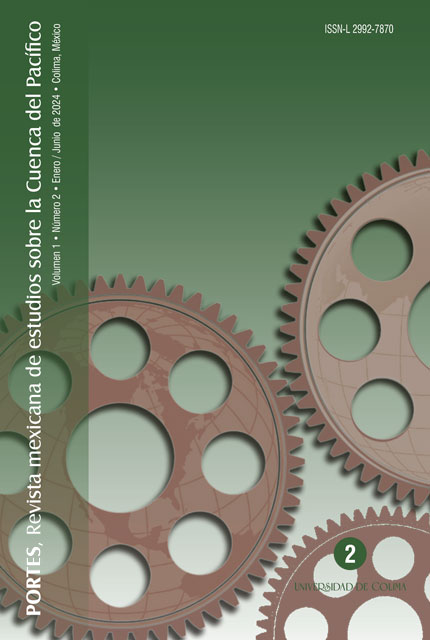A comparison between global governance at the beginning of the 20th century and the beginning of the 21st century. A new imperialist dispute?
DOI:
https://doi.org/10.53897/RevPortes.2024.02.05Keywords:
United States of America, China, Multipolarity, Imperialism, Global competitionAbstract
The past ten years have witnessed a growing rivalry in various orders between East Asia, led by China and Russia and the West, led by the United States and its allies. This phenomenon of contemporary geopolitics refers us to the phenomenon of the replacement of British hegemony in the late nineteenth century and the conflicts that followed in the early twentieth century until the end of WWII when the United States became the hegemonic power of the capitalist world and a system of governance based on the Bretton Woods Agreements. The text uses historical and documentary bibliographic information to compare the historical framework, similarities and differences between these two historical moments. The main conclusion is that there is a rivalry for institutionality and future governance, something that was absent in the early nineteenth century, in which liberal theses and territorial imperialism predominated. The constitution of the BRICS+ (Brazil, Russia, India, China, South Africa, and the newly incorporated countries) constitutes a challenge in the consolidation of a new multipolar governance, a new phenomenon, and therefore, a geopolitical challenge for the construction of a new global order that replaces a single hegemonic power like the one that occurred at the end of WWII.
Downloads
Metrics
References
Anguiano Rock, E. (2008). China como potencia mundial: presente y futuro. In R. Cornejo (Ed.), China. Radiografía de una potencia en ascenso. El Colegio de México. DOI: https://doi.org/10.2307/j.ctv3dnrbc
Cornejo, R. (Ed.). (2008). China. Radiografía de una potencia. El Colegio de México.
Frenke, H., & Trauzettel, R. (2006). El Imperio chino (Vol. 19). Editorial Siglo XXI.
Fukuyama, F. (1992). El fin de la historia y el último hombre. Ed. Planeta.
Garnaut, R., & Song, L. (Eds.). (2006). The turning point for China’s economic development. The Australian National University. DOI: https://doi.org/10.26530/OAPEN_459745
Garnaut, R., Song, L., & Fang, C. (Eds.). (2018). China’s 40 years of reform and development 1978-2018. Australian National University, Social Sciences Academic Press (China). DOI: https://doi.org/10.22459/CYRD.07.2018
Gerschenkron, A. (1968). El atraso económico en la perspectiva histórica. Investigación Económica, 28(111/112), 141-165.
Hall, J. W. (1968). El imperio japonés (Vol. 20). Editorial Siglo veintiuno.
Harvey, D. (2004). El nuevo imperialismo (Vol. 26). Ediciones Akal, S. A.
Hilferding, R. (1971). El capital Financiero. Editorial de Ciencias Sociales, Instituto Cubano del Libro.
Hobsbawn, E. (2007). La Era del Imperio, 1875-1914. Grupo Editorial Planeta.
Kocamaz, Ü. (2019). The rise of new powers in world politics Russia, China and the Shangai Cooperation. Uluslararasi Iliskiler Dergisi / International Relations, 16(61), 127-141.
Lenin, V. I. (2016). El imperialismo, fase superior del capitalismo. Editorial Cienflores.
Luxemburg, R. (2003). The Accumulation of Capital. Routledge.
Mandel, E. (1972). El capitalismo tardío. Ediciones Era.
Ohno, K. (2006). The Economic Development of Japan. GRIPS Development Forum, National Graduate Institute for Policy Studies.
Tamames, R., & Huerta, B. G. (2010). Estructura Económica Internacional. Alianza Editorial; ICEX (Instituto Español de Comercio Exterior);.
Vázquez Rojo, J. (2022). United States, China and the Dispute for Global Hegemony: a Comparative Analysis. Human Review, 2-13. DOI: https://doi.org/10.37467/revhuman.v11.4302
Zinn, H. (2011). La otra historia de los Estados Unidos. Editorial Siete Cuentos.
Downloads
Published
How to Cite
Issue
Section
License
Copyright (c) 2024 University of Colima

This work is licensed under a Creative Commons Attribution-NonCommercial-ShareAlike 4.0 International License.
La revista PORTES de la Universidad de Colima se distribuye bajo una Licencia Creative Commons Atribución-NoComercial-CompartirIgual 4.0 Internacional





